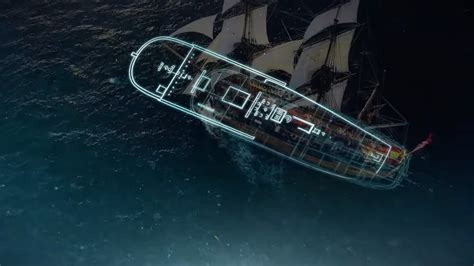
The shipwreck believed to be Captain James Cook’s famed Endeavour, which played a crucial role in his first voyage of discovery, has been definitively identified off the coast of Rhode Island, ending a decades-long maritime mystery. The Rhode Island Marine Archaeology Project (RIMAP) confirmed the wreck’s identity, stating it aligns with historical and archaeological evidence associated with the Endeavour, which was intentionally sunk by the British during the American Revolution in 1778.
The confirmation comes after years of debate and speculation surrounding a cluster of shipwrecks in Newport Harbor. RIMAP, which has been studying the wrecks since 1993, used extensive documentation, including historical records, ship construction techniques, and artifact analysis, to link the wreck site to the Endeavour. The project has faced challenges from other organizations, including the Australian National Maritime Museum, which previously announced a different wreck site as the Endeavour in 2022. RIMAP disputes that claim.
“RIMAP can now state that the Endeavour has been found,” the organization announced in a statement. The discovery provides a significant opportunity to learn more about 18th-century maritime history, naval warfare, and the life of Captain Cook, whose voyages significantly shaped European understanding of the Pacific Ocean. The confirmation also opens new avenues for archaeological research and preservation efforts aimed at protecting this historically significant wreck site.
A Long and Complicated History
The story of the Endeavour is one of transformation and ultimate sacrifice. Launched in 1764 as the collier Earl of Pembroke, the vessel was purchased by the British Royal Navy in 1768 and renamed Endeavour. It was then refitted for a scientific expedition to the Pacific, led by Lieutenant James Cook.
Cook’s first voyage (1768-1771) aboard the Endeavour is renowned for its exploration of the Pacific, including charting the coasts of New Zealand and Australia. The voyage’s primary objective was to observe the transit of Venus from Tahiti, a scientific endeavor aimed at calculating the distance between the Earth and the Sun. However, Cook’s instructions also included searching for the hypothetical southern continent, Terra Australis Incognita.
During the voyage, the Endeavour faced numerous challenges, including navigating treacherous waters, enduring storms, and encountering hostile indigenous populations. In 1770, the ship ran aground on the Great Barrier Reef, suffering significant damage. The crew managed to repair the vessel and continue the voyage, returning to England in 1771.
Following its return, the Endeavour was deemed no longer suitable for long voyages of exploration. It was sold to private owners in 1775 and renamed the Lord Sandwich. The ship was used to transport troops and supplies during the American Revolutionary War. In 1778, the Lord Sandwich, along with several other vessels, was intentionally sunk in Newport Harbor, Rhode Island, as part of a British effort to blockade the port and prevent French forces from entering. This mass scuttling created a barrier of sunken ships, hindering enemy naval movements. The Endeavour‘s final resting place, therefore, became a watery grave, its identity lost to time until recent archaeological investigations.
The Archaeological Investigation
The search for the Endeavour has been a long and arduous process, spanning decades and involving multiple organizations. RIMAP began its investigation of the Newport Harbor shipwrecks in 1993, meticulously mapping and excavating several sites. The project faced numerous challenges, including poor visibility, strong currents, and the sheer complexity of identifying a single vessel among a group of wrecks.
Over the years, RIMAP has employed various techniques to identify the Endeavour, including archival research, remote sensing surveys, and underwater excavation. Archival research involved scouring historical records, such as ship manifests, naval documents, and personal journals, for clues about the Endeavour‘s construction, dimensions, and final location. Remote sensing surveys used sonar and other technologies to create detailed maps of the seabed, identifying potential shipwreck sites. Underwater excavation involved carefully removing sediment and debris from the wreck sites, documenting the remains, and recovering artifacts.
One of the key pieces of evidence supporting RIMAP’s identification of the Endeavour is the ship’s construction techniques. The Endeavour was built as a collier, a type of ship designed to transport coal. Colliers had distinctive construction features, such as a flat bottom and sturdy hull, to withstand the rigors of carrying heavy loads in shallow waters. RIMAP’s analysis of the wreck site revealed that the vessel was indeed built using collier construction techniques, aligning with the historical record of the Endeavour.
Another important line of evidence is the artifacts recovered from the wreck site. RIMAP has recovered thousands of artifacts, including ceramics, glass, metal objects, and ship fittings. Some of these artifacts are consistent with the Endeavour‘s historical context, such as British naval items and objects associated with Cook’s voyage.
The Australian National Maritime Museum (ANMM) entered the fray in 1999, conducting its own research and analysis of the Newport Harbor shipwrecks. In 2018, the ANMM announced that it had identified a specific wreck site as the Endeavour. However, RIMAP disputed the ANMM’s claim, arguing that the evidence was inconclusive and that the ANMM had not adequately considered all the available data.
The disagreement between RIMAP and the ANMM highlights the challenges of identifying shipwrecks and the importance of rigorous scientific methodology. The identification of a shipwreck requires a convergence of evidence from multiple sources, including historical records, archaeological data, and scientific analysis. It is crucial to carefully evaluate all the available evidence and to avoid making premature conclusions.
The Dispute with the Australian National Maritime Museum
The announcement by the Australian National Maritime Museum (ANMM) in 2022 that they had identified the Endeavour triggered a significant controversy and highlighted the complexities of maritime archaeology. The ANMM based its identification on a combination of historical documents, remote sensing data, and limited archaeological investigation. However, RIMAP vehemently disagreed with the ANMM’s conclusions, citing discrepancies in the evidence and questioning the methodology used by the Australian team.
One of the main points of contention was the location of the wreck site. RIMAP argued that the wreck identified by the ANMM was not in the correct location based on historical records and maps of the Newport Harbor area. RIMAP also pointed out that the ANMM’s wreck site did not align with the known dimensions and construction features of the Endeavour.
Another area of disagreement was the interpretation of the archaeological evidence. RIMAP argued that the artifacts recovered from the ANMM’s wreck site were not definitively linked to the Endeavour and could have come from other vessels sunk in Newport Harbor. RIMAP also criticized the ANMM for not conducting a more thorough excavation of the wreck site, which would have provided more data to support its identification.
The dispute between RIMAP and the ANMM underscores the challenges of maritime archaeology and the importance of independent verification. The identification of a shipwreck is a complex process that requires careful analysis of multiple lines of evidence. It is essential to have independent teams of experts evaluate the evidence and to reach a consensus based on the available data.
The current announcement by RIMAP reaffirms their long-held position and is based on their decades of research, which they believe provides a more comprehensive and accurate picture of the Endeavour‘s final resting place. The ongoing debate highlights the passion and dedication of archaeologists and historians to uncovering the mysteries of the past.
Implications of the Discovery
The definitive identification of the Endeavour has significant implications for maritime history, archaeology, and cultural heritage. The discovery provides a unique opportunity to learn more about 18th-century shipbuilding techniques, naval warfare, and the life of Captain Cook.
The Endeavour is one of the most iconic ships in maritime history, known for its role in Cook’s first voyage of discovery. The voyage was a pivotal moment in European exploration of the Pacific, leading to the charting of New Zealand and Australia and the expansion of European influence in the region. The discovery of the Endeavour provides a tangible link to this important historical event.
The wreck site also offers a treasure trove of archaeological information. The artifacts recovered from the site can provide insights into the daily life of sailors in the 18th century, the types of goods that were transported on ships, and the technologies that were used for navigation and communication.
The Endeavour is also a symbol of cultural heritage for both Britain and Australia. The ship represents the shared history of these two nations and the legacy of exploration and discovery. The discovery of the Endeavour can help to promote greater understanding and appreciation of this shared heritage.
However, the discovery also raises important questions about the preservation and management of the wreck site. The Endeavour is a fragile historical resource that is vulnerable to damage from natural processes and human activities. It is essential to develop a comprehensive plan for the preservation and management of the site to ensure that it is protected for future generations.
Preservation Efforts and Future Research
The preservation of the Endeavour wreck site presents significant challenges due to its location in Newport Harbor. The harsh marine environment, with strong currents, fluctuating tides, and the presence of marine organisms, can accelerate the deterioration of the shipwreck. Additionally, the wreck site is vulnerable to damage from boat traffic, fishing activities, and potential looting.
To address these challenges, RIMAP is working with various organizations, including the Rhode Island Historical Preservation & Heritage Commission, the National Oceanic and Atmospheric Administration (NOAA), and the Australian National Maritime Museum, to develop a comprehensive preservation plan. The plan includes measures to stabilize the wreck site, monitor its condition, and protect it from damage.
One of the key elements of the preservation plan is to conduct a detailed assessment of the wreck site’s condition. This assessment will involve underwater surveys, photographic documentation, and the collection of samples for analysis. The data collected will be used to develop a conservation strategy that is tailored to the specific needs of the Endeavour.
Another important aspect of the preservation plan is to raise public awareness about the Endeavour and its significance. RIMAP is working to develop educational programs, exhibits, and online resources to inform the public about the ship’s history, the archaeological investigation, and the importance of preserving maritime heritage.
Future research on the Endeavour wreck site will focus on several key areas. One area of research is to conduct a more detailed excavation of the wreck site to recover additional artifacts and to gain a better understanding of the ship’s construction and layout. This excavation will be conducted using careful archaeological techniques to minimize damage to the wreck site.
Another area of research is to study the artifacts recovered from the wreck site to learn more about the daily life of sailors in the 18th century. This research will involve analyzing the artifacts’ materials, manufacturing techniques, and use patterns. The results of this research will be used to create exhibits and educational programs that bring the Endeavour‘s story to life.
Finally, researchers will continue to study the historical records and archival documents related to the Endeavour to gain a deeper understanding of the ship’s history and its role in maritime exploration. This research will involve collaborating with historians, archivists, and other experts from around the world.
The Significance of Captain James Cook
Captain James Cook (1728-1779) was a British explorer, navigator, cartographer, and captain in the Royal Navy. He made three voyages to the Pacific Ocean, during which he achieved numerous accomplishments, including charting the coasts of New Zealand and Australia, mapping the Hawaiian Islands, and exploring the coasts of North America.
Cook’s voyages were driven by a combination of scientific curiosity, imperial ambition, and the desire to expand European knowledge of the world. He was a skilled navigator and cartographer, using the latest technology and techniques to create accurate maps and charts of the regions he explored. He was also a capable leader, maintaining discipline and morale among his crew in the face of challenging conditions.
Cook’s voyages had a profound impact on the Pacific region and on European understanding of the world. His accurate maps and charts opened up the Pacific to European trade and colonization. His scientific observations contributed to the advancement of knowledge in fields such as botany, zoology, and astronomy. His encounters with indigenous populations led to increased awareness of different cultures and ways of life.
Cook’s legacy is complex and contested. He is celebrated as a hero in Britain and Australia for his achievements in exploration and navigation. However, he is also criticized for his role in the colonization of the Pacific and for the negative impacts of European contact on indigenous populations.
Despite the controversies surrounding his legacy, Cook remains one of the most important figures in maritime history. His voyages transformed European understanding of the Pacific and paved the way for further exploration and colonization. The discovery of the Endeavour provides a tangible link to Cook’s life and accomplishments and offers a valuable opportunity to learn more about this pivotal period in history.
Frequently Asked Questions (FAQ)
-
Is it absolutely certain that the wreck found off Rhode Island is the Endeavour?
RIMAP states with confidence that the wreck is indeed the Endeavour. They base this assertion on decades of research, comparing historical documents, ship construction techniques, and artifacts found at the site with known characteristics of the Endeavour. However, debates and differing interpretations may continue, as evidenced by the past disagreements with the Australian National Maritime Museum. The organization believes the totality of the evidence points conclusively to the wreck’s identity.
-
Why was the Endeavour sunk?
The Endeavour, then renamed the Lord Sandwich, was intentionally scuttled in 1778 by the British during the American Revolutionary War as part of a blockade strategy in Newport Harbor, Rhode Island. The sinking was intended to prevent French ships from entering the harbor and assisting the American colonists.
-
What will happen to the wreck now that it has been identified?
The Rhode Island Marine Archaeology Project (RIMAP) aims to protect and preserve the wreck site. Efforts will likely include continued monitoring of the wreck’s condition, development of a conservation strategy, and measures to protect it from damage due to boat traffic or looting. Public education programs and exhibits are also planned to raise awareness about the Endeavour‘s history and significance. Further archaeological investigation is also likely to occur, if funding permits.
-
How much of the Endeavour still remains?
Unfortunately, not much of the Endeavour remains intact. Being submerged for centuries and intentionally scuttled, the wreck has deteriorated significantly. Initial findings suggest that approximately 15% of the ship’s structure is still present on the seabed. The most significant remaining portions are the lower hull sections.
-
What is the dispute with the Australian National Maritime Museum about?
The dispute arose because the Australian National Maritime Museum (ANMM) had previously announced that it had identified a different wreck site in Newport Harbor as the Endeavour in 2018. RIMAP disagreed with the ANMM’s identification, citing inconsistencies in the evidence and questioning the methodology used by the Australian team. RIMAP argued that the ANMM’s wreck site did not align with the known dimensions and construction features of the Endeavour, and that the artifacts recovered were not definitively linked to the ship. RIMAP maintains that its own research provides a more accurate identification based on a comprehensive analysis of historical and archaeological data.









